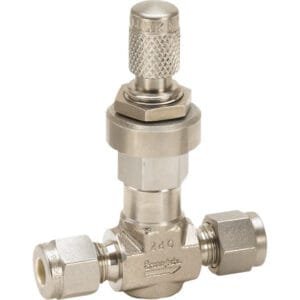Fluorocarbon Gaskets (Molded) for ConFlat (CF) UHV Flanges
TFM’s Fluorocarbon Gaskets (Molded) for ConFlat (CF) UHV Flanges are specially engineered to deliver superior sealing performance in ultra-high vacuum (UHV) applications. Crafted from high-quality fluorocarbon materials like Viton® or equivalent, these molded gaskets are perfect for maintaining leak-tight seals under extreme conditions. Whether in semiconductor manufacturing, vacuum processing, or research environments, TFM’s molded fluorocarbon gaskets provide exceptional resistance to harsh chemicals, extreme temperatures, and high vacuum levels, ensuring reliable and durable sealing.
Key Features
Molded Design for Precision
The molded design ensures that each gasket fits perfectly with ConFlat (CF) UHV flanges, providing uniform compression across the sealing surface. This guarantees a reliable seal and minimizes the risk of leaks, even in demanding environments.High-Quality Fluorocarbon Material
Made from top-tier fluorocarbon compounds, these gaskets exhibit excellent chemical resistance and high-temperature stability. The material ensures durability and optimal performance even in harsh operating environments.Temperature and Chemical Resistance
Fluorocarbon gaskets are designed to withstand extreme temperature ranges, from cryogenic conditions up to high temperatures (typically -20°C to 250°C, or -4°F to 482°F). These gaskets also provide outstanding resistance to chemicals, including acids, bases, and solvents, making them ideal for a wide range of applications.Leak-Tight Performance
These gaskets are specifically engineered to create a leak-tight seal under ultra-high vacuum conditions. Their superior sealing capability prevents gas or fluid leakage, ensuring the integrity of the system in critical applications.Long-Term Durability
The molded fluorocarbon gaskets are resistant to compression set, ensuring they maintain their shape and sealing properties over time. This long-term durability reduces the need for frequent gasket replacements, offering a cost-effective solution for high-performance systems.
Applications
Ultra-High Vacuum Systems
Perfect for use in UHV systems, TFM’s molded fluorocarbon gaskets provide a reliable seal for equipment where minimal outgassing and low leak rates are essential. They are commonly used in research labs, semiconductor manufacturing, and other precision vacuum applications.Semiconductor Manufacturing
In semiconductor production, these gaskets are used in critical vacuum-based processes such as plasma etching, chemical vapor deposition (CVD), and physical vapor deposition (PVD), ensuring a clean and stable vacuum environment.Research and Laboratory Applications
These gaskets are ideal for applications in particle accelerators, electron microscopes, and other vacuum-based research equipment, where consistent and reliable vacuum conditions are required.Aerospace and Vacuum Technologies
Fluorocarbon gaskets are also suitable for aerospace applications, including satellite systems and vacuum chambers, where performance and durability in extreme vacuum conditions are crucial.
Specifications
Material: Fluorocarbon (Viton® or equivalent)
Design: Molded gaskets for ConFlat (CF) UHV flanges
Temperature Range: -20°C to 250°C (-4°F to 482°F)
Pressure Rating: Suitable for UHV and HV environments
Chemical Resistance: Excellent resistance to most acids, bases, and solvents
Compatibility: Designed for use with ConFlat (CF) UHV flanges
Why Choose TFM?
TFM’s Fluorocarbon Gaskets (Molded) for ConFlat (CF) UHV Flanges provide unmatched sealing performance in demanding ultra-high vacuum systems. With superior chemical and temperature resistance, these gaskets ensure long-term reliability and prevent leaks, making them an essential component for maintaining the integrity of vacuum-based systems. Choose TFM for high-quality, durable, and cost-effective sealing solutions for your most critical applications.





Reviews
There are no reviews yet.